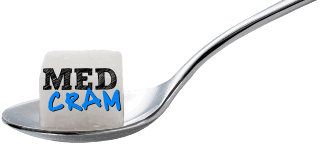In this video, Dr. Seheult of MedCram discusses the recent study that shows how hydrocortisone was found to reduce mortality in severe community-acquired pneumonia. This is potential turning point in a major disease treatment. This study was a phase 3 multi-centered randomized, double blinded study that showed hydrocortisone (a steroid) can reduce mortality at 28 days in a common diagnosis of severe community acquired pneumonia.
What did the trial show?
This trial took place in France in patients that were admitted to the hospital with severe community acquired pneumonia. It had a total of 800 participants and found that an infusion of hydrocortisone over an 8 or 14 day period showed a reduction in mortality from 11.9% in the placebo group to 6.2% in the intervention group at 28 days. This advantage held out at 90 days with a mortality of 14.7 % in the placebo group and 9.3% in the treatment group. When the incidence of intubation (putting a tube down the throat into the lungs) was reviewed at 28 days, it was decreased from 29.5% in the placebo group to 18% in the intervention group. Likewise the incidence of vasopressor use (medication to elevate the blood pressure) was reduced from 25% in the placebo group to 15.3% in the intervention group at day 28. It was noted that the insulin usage per day was higher in the intervention arm compared to the placebo arm. This is a known side effect of hydrocortisone as it can lead to increases in the blood sugar.
Inclusion and exclusion criteria
The inclusion criteria in this study are important as this treatment is not for all individuals who come to the hospital. The criteria included age 18 plus, have community acquired pneumonia, have abnormal chest x-ray or CT and a diagnosis within 48 hours. The intervention had to be started within 24 hours of the first severity score and they had to have received antibiotics already. This needed to be a severe pneumonia, so the PSI/PORT score had to be greater than 130. This score is a way to calculate the pneumonia severity index and the higher the score, the higher likelihood of mortality. The patients could have required intubation or had a high oxygen requirement of FiO2>50% or required a partial rebreathing mask. Exclusion criteria included being on vasopressors initially, other types of pneumonia such as aspiration or post obstructive, fungal pneumonia, influenza, active TB, immunosuppressed, no mechanical ventilation within the past 14 days, not on antibiotics more than 7 days, could not have been on hydrocortisone for another problem, and not pregnant.
How was the study done?
The study started off with 5948 patients and this number was whittled down to 800 patients after following the inclusion and exclusion criteria. There were 400 put into the intervention group and 400 into the placebo group. The hydrocortisone was administered by 200 mg continuous IV infusion and at day 4 it was decided whether the participants would continue the treatment for a total of 8 days or 14 days. This was determined by looking at the following criteria: if the patient was breathing spontaneously, the P/F ratio greater than 200 (this is the measurement of the oxygen in the blood divided by the concentration of oxygen the patient is breathing>the lower the number the worse the patient is doing), the SOFA score improved (Sequential Organ Failure Assessment score which is a predictor of ICU mortality), and it was likely the patient would be discharged on day 14. If these were met, then patients were included in the 8 day trial. If not, they would do the 14 day trial. All four criteria had to be met.
Statistical numbers
The relative risk reduction was 48% and the absolute risk reduction was 5.7 %. The NNT (Number needed to treat) was 18. The higher this number the less efficacious the treatment is and a number of 18 is a good number.
Risks in the trial?
What are the risks of hydrocortisone? This includes elevated blood sugar, but also as this drug is a steroid, it can cause ulcers in the stomach which could lead to GI bleeding, and lead to hospital acquired infections due to its immunosuppressive properties. This study did not report any statistically significant findings of GI bleed or hospital acquired infections.
These results will undoubtedly be reviewed by the major medical societies such as the Infectious Disease Society of America, and it remains to be seen if this information will be included in their guideline recommendations.
MedCram does offer a course on pneumonia for further information.
LINKS / REFERENCES:
Hydrocortisone in Severe Community-Acquired Pneumonia (NEJM) | https://www.nejm.org/doi/10.1056/NEJM…
PSI/PORT Score: Pneumonia Severity Index for CAP (MDCalc) | https://www.mdcalc.com/calc/33/psi-po…
Pneumonia Explained Clearly (MedCram) | https://www.medcram.com/courses/pneum..
